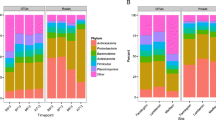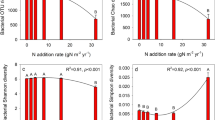Abstract
Background and aims
Plant impacts on soil microbial community composition and function are believed to be important but remain poorly understood. We looked at the bacterial community effects of growing two different plant species in soils with differing plant growth histories.
Methods
Big bluestem (Andropogon gerardii: Ag) and cereal rye (Secale cereale: Sc) plants were grown in six soils with different planting and management histories for 14 weeks in a greenhouse study. Both prior to planting and harvesting, soil was collected for analysis. Bacterial community DNA was extracted and analyzed via 454 pyrosequencing and soil edaphic characteristics were also measured.
Results
Significant shifts in composition were observed between pre-plant and post-plant bacterial communities in 23 of the 40 most abundant orders but only one order (Nitrospirales) differed significantly between the two plant species treatments (Ag vs. Sc). Compared to pre-plant communities, post-plant communities increased significantly in alpha diversity (within community) but exhibited an overall decrease in beta diversity (between community), indicating that soil communities became more similar after growth of either Ag or Sc. Soil pH was the strongest predictor of bacterial community ordination, followed by percent carbon, organic matter, phosphorous, nitrogen, and potassium.
Conclusions
Overall, the relative lack of significant differences between the soil bacterial communities of Ag- and Sc-planted soils suggests that potential plant-species-specific effects are strongly modulated by growth conditions and edaphic soil characteristics.





Similar content being viewed by others

References
Barnes JP, Putnam AR (1987) Role of benzoxazinones in allelopathy by rye (Secale cereale L.). J Chem Ecol 13:889–906. doi:10.1007/BF01020168
Bartram AK, Lynch MDJ, Stearns JC, Moreno-Hagelsieb G, Neufeld JD (2011) Generation of multimillion-sequence 16S rRNA gene libraries from complex microbial communities by assembling paired-end illumina reads. Appl Environ Microbiol 77:3846–3852
Baselga A, Orme CDL (2012) betapart: an R package for the study of beta diversity. Methodol Ecol Evol 3:808–812
Berg G, Smalla K (2009) Plant species and soil type cooperatively shape the structure and function of microbial communities in the rhizosphere. FEMS Microbiol Ecol 68:1–13
Buée M, Reich M, Murat C, Morin E, Nilsson RH, Uroz S, Martin F (2009) 454 Pyrosequencing analyses of forest soils reveal an unexpectedly high fungal diversity. New Phytol 184:449–456
Bulgarelli D, Rott M, Schlaeppi K, van Themaat EVL, Ahmadinejad N, Assenza F et al (2012) Revealing structure and assembly cues for Arabidopsis root-inhabiting bacterial microbiota. Nature 488:91–95
Caporaso JG, Lauber CL, Walters WA, Berg-Lyons D, Lozupone CA, Turnbaugh PJ, Fierer N, Knight R (2010) Colloquium Paper: Global patterns of 16S rRNA diversity at a depth of millions of sequences per sample. Proc Natl Acad Sci U S A 108:4516–4522
Casper BB, Castelli JP (2007) Evaluating plant–soil feedback together with competition in a serpentine grassland. Ecol Lett 10:394–400
Charlson RJ, Rodhe H (1982) Factors controlling the acidity of natural rainwater. Nature 295:683–685
De Mendiburu, F (2007) Agricolae: statistical procedures for agricultural research, R package version 10–3
Dohrmann AB, Küting M, Jünemann S, Jaenicke S, Schlüter A, Tebbe CC (2013) Importance of rare taxa for bacterial diversity in the rhizosphere of Bt- and conventional maize varieties. ISME J 7:37–49
Duineveld BM, Rosado AS, van Elsas JD, van Veen JA (1998) Analysis of the dynamics of bacterial communities in the rhizosphere of the chrysanthemum via denaturing gradient gel electrophoresis and substrate utilization patterns. Appl Environ Microbiol 64:4950–4957
Duineveld BM, Kowalchuk GA, Keijzer A, van Elsas JD, van Veen JA (2001) Analysis of the bacterial communities in the rhizosphere of chrysanthemum via denaturing gradient gel electrophoresis of PCR-amplified 16S rRNA as well as DNA fragments coding for 16S rRNA. Appl Environ Microbiol 67:172–178
Edgar RC, Haas BJ, Clemente JC, Quince C, Knight R (2011) UCHIME improves sensitivity and speed of chimera detection. Bioinformatics 27:2194–2200
Fang C, Radosevich M, Fuhrmann JJ (2001) Characterization of rhizosphere microbial community structure in five similar grass species using FAME and BIOLOG analyses. Soil Biol Biochem 33:679–682
Garbeva O, van Veen JA, van Elsas JD (2004) Microbial diversity in soil: selection of microbial populations by plant and soil type and implications for disease suppressiveness. Annu Rev Phytopathol 42:243–270
Garbeva O, Postma J, van Veen JA, van Elsas JD (2006) Effect of above-ground plant species on soil microbial community structure and its impact on suppression of Rhizoctonia solani. Environ Microbiol 8:233–246
Garbeva P, Van Elsas J, Van Veen J (2008) Rhizosphere microbial community and its response to plant species and soil history. Plant Soil 302:19–32
Giller PS (1996) The diversity of soil communities, the “poor man”s tropical rainforest’. Biodivers Conserv 5:135–168
Grayston SJ, Wang S, Campbell CD, Edwards AC (1998) Selective influence of plant species on microbial diversity in the rhizosphere. Soil Biol Biochem 30:369–378
Haichar FZ, Marol C, Berge O, Rangel-Castro JI, Prosser JI, Balesdent J, Heulin T, Achouak W (2008) Plant host habitat and root exudates shape soil bacterial community structure. ISME J 2:1221–1230
Hinsinger P, Plassard C, Tang C, Jaillard B (2003) Origins of root-mediated pH changes in the rhizosphere and their responses to environmental constraints: A review. Plant Soil 248:43–59
İnceoğlu Ö, Al-Soud WA, Salles JF, Semenov AV, Van Elsas JD (2011) Comparative analysis of bacterial communities in a potato field as determined by pyrosequencing. PLoS One 6:e23321
Innes L, Hobbs P, Bardgett R (2004) The impacts of individual plant species on rhizosphere microbial communities in soils of different fertility. Biol Fert Soils 40:7–13
Kielak A, Pijl AS, Van Veen JA, Kowalchuk GA (2008) Differences in vegetation composition and plant species identity lead to only minor changes in soil-borne microbial communities in a former arable field. FEMS Microbiol Ecol 63:372–382
Kinkel LL, Schlatter DC, Bakker MG, Arenz BE (2012) Streptomyces competition and co-evolution in relation to plant disease suppression. Res Microbiol 163:490–499
Kourtev P, Ehrenfeld J, Häggblom M (2003) Experimental analysis of the effect of exotic and native plant species on the structure and function of soil microbial communities. Soil Biol Biochem 35:895–905
Kowalchuk G, Buma D, De Boer W, Klinkhamer P, Van Veen J (2002) Effects of above-ground plant species composition and diversity on the diversity of soil-borne microorganisms. Anton van Leeuw 81:509–520
Lau JA, Lennon JT (2012) Rapid responses of soil microorganisms improve plant fitness in novel environments. Proc Natl Acad Sci U S A 109:14058–14062
Lauber CL, Hamady M, Knight R, Fierer N (2009) Pyrosequencing-based assessment of soil pH as a predictor of soil bacterial community structure at the continental scale. Appl Environ Microbiol 75:5111–5120
Lupwayi NZ, Rice WA, Clayton GW (1998) Soil microbial diversity and community structure under wheat as influenced by tillage and crop rotation. Soil Biol Biochem 30:1733–1741
Marilley L, Aragno M (1999) Phylogenetic diversity of bacterial communities differing in degree of proximity of Lolium perenne and Trifolium repens roots. Appl Soil Ecol 13:127–136
Marschner P, Yang C-H, Lieberei R, Crowley D (2001) Soil and plant specific effects on bacterial community composition in the rhizosphere. Soil Biol Biochem 33:1437–1445
Marschner P, Crowley D, Yang CH (2004) Development of specific rhizosphere bacterial communities in relation to plant species, nutrition and soil type. Plant Soil 261:199–208
Mercik S (1994) The most important soil properties and yields in long-term static fertilization experiments at Skierniewice. Roczniki Gleboznawcze 44:71–78
Nacke H, Thürmer A, Wolherr A, Will C, Hodac L et al (2011) Pyrosequencing-Based Assessment of Bacterial Community Structure Along Different Management Types in German Forest and Grassland Soils. PLoS One 6(2):e17000. doi:10.1371/journal.pone.0017000
Oksanen J, Kindt R, Legendre P, O’Hara RB (2005) Vegan: community ecology package Version 17–81 http://cran.r-projectorg/
R Development Core Team (2011) R: A language and environment for statistical computing. R Foundation for Statistical Computing, Vienna, Austria ISBN 3-900051-07-0, URL http://www.R-projectorg/
Roesch LFW, Fulthorpe RR, Riva A, Casella G, Hadwin AKM, Kent AD, Daroub SH, Camargo FAO, Farmerie WG, Triplett EW (2007) Pyrosequencing enumerates and contrasts soil microbial diversity. ISME J 1:283–290
Sattell R, Dick R, Karow R, Kaufman D, Hemphill D, Luna J, McGrath D (1998) Cereal Rye. Oregon State University Extension Service. http://ir.library.oregonstate.edu/xmlui/bitstream/handle/1957/14957/em8694.pdf. Accessed 20 May 2014
Schloss PD, Westcott SL, Ryabin T, Hall JR, Hartmann M, Hollister EB, Lesniewski RA, Oakley BB, Parks DH, Robinson CJ, Sahl JW, Stres B, Thallinger GG, Horn DJV, Weber CF (2009) Introducing mothur: open-source, platform-independent, community-supported software for describing and comparing microbial communities. Appl Environ Microbiol 75:7537–7541
Shange RS, Ankumah RO, Ibekwe AM, Zabawa R, Dowd SE (2012) Distinct soil bacterial communities revealed under a diversely managed agroecosystem. PLoS One 7(7):e40338. doi:10.1371/journal.pone.0040338
Smalla K, Wieland G, Buchner A, Zock A, Parzy J, Kaiser S, Roskot N, Heuer H, Berg G (2001) Bulk and rhizosphere soil bacterial communities studied by denaturing gradient gel electrophoresis: plant-dependent enrichment and seasonal shifts revealed. Appl Environ Microbiol 67:4742–4751
Steer J, Harris JA (2000) Shifts in the microbial community in rhizosphere and non-rhizosphere soils during the growth of Agrostis stolonifera. Soil Biol Biochem 32:869–878
Teixeira LCRS, Peixoto RS, Cury JC, Sul WJ, Pellizari VH, Tiedje J, Rosado AS (2010) Bacterial diversity in rhizosphere soil from Antarctic vascular plants of Admiralty Bay, maritime Antarctica. ISME J 4:989–1001
Uroz S, Buée M, Murat C, Frey-Klett P, Martin F (2010) Pyrosequencing reveals a contrasted bacterial diversity between oak rhizosphere and surrounding soil. Environ Microb Rep 2:281–288
Uroz S, Oger P, Moring E, Frey-Klett P (2012) Distinct ectomycorrhizospheres share similar bacterial communities as revealed by pyrosequencing-based analysis of 16S rRNA genes. Appl Environ Microbiol 78:3020–3024
Van Der Heijden MGA, Bardgett RD, Van Straalen NM (2008) The unseen majority: soil microbes as drivers of plant diversity and productivity in terrestrial ecosystems. Ecol Lett 11:296–310
Wiklander L (1974) The acidification of soil by acid precipitation. Grundforbaettring 26:155–164
Yin C, Jones KL, Peterson DE, Garrett KA, Hulbert SH, Paulitz TC (2010) Members of soil bacterial communities sensitive to tillage and crop rotation. Soil Biol Biochem 42:2111–2118
Acknowledgements
We thank Ronald Faber at the Sand Plain Research Farm for assistance with soil selection and history. We also thank Chris Wright at the Roy Carver Biotechnology Center for assistance with sample preparation for pyrosequencing. Also thanks to Laura Felice, Jon Anderson and Phil Manlick for assistance with plant harvesting and processing. Thanks to Pat Schloss and Sarah Westcott for advice with sequence processing via Mothur and to the Minnesota Supercomputing Institute for use of computing resources. This research was funded by National Science Foundation Microbial Observatories Program (Grant #9,977,907), United States Department of Agriculture Microbial Observatories (Grant # 2006-35,319-17,445), USDA-NIFA (Grant # 2011 67,019-30,330), and the University of Minnesota Agricultural Experiment Station Project (#MIN 22–018).
Author information
Authors and Affiliations
Corresponding author
Additional information
Responsible Editor: Gera Hol.
Rights and permissions
About this article
Cite this article
Arenz, B.E., Bradeen, J.M., Otto-Hanson, L.K. et al. Two grass species fail to display differing species-specific effects on soil bacterial community structures after one season of greenhouse growth. Plant Soil 385, 241–254 (2014). https://doi.org/10.1007/s11104-014-2226-2
Received:
Accepted:
Published:
Issue Date:
DOI: https://doi.org/10.1007/s11104-014-2226-2



